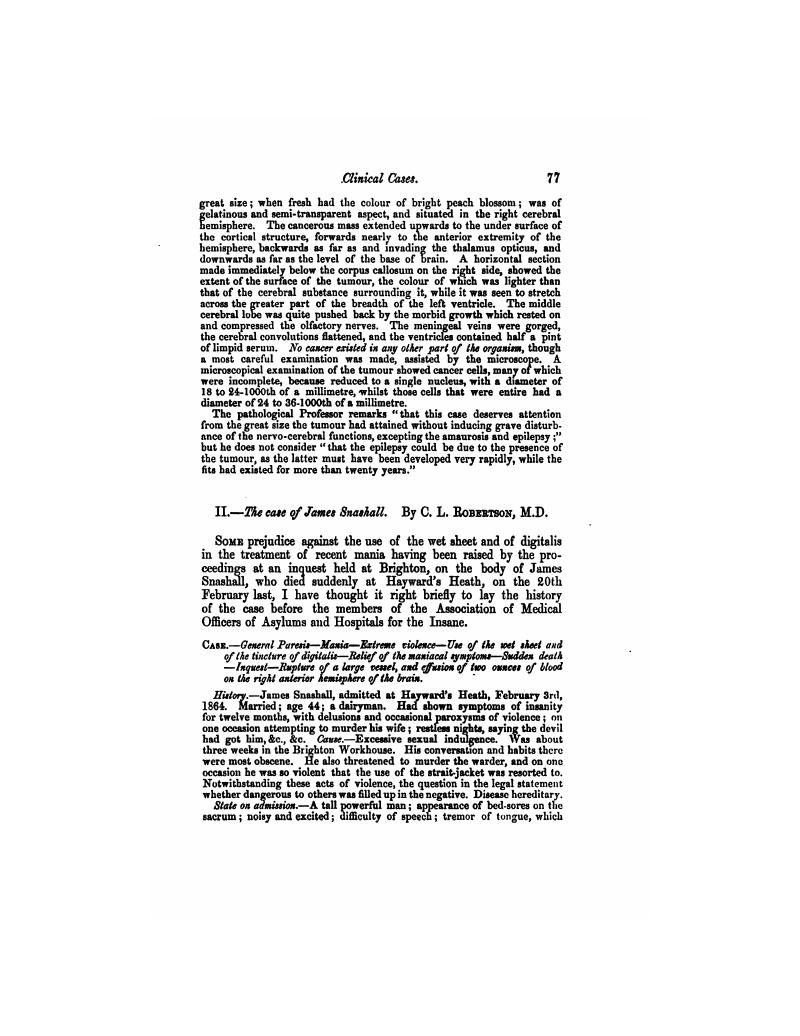No CrossRef data available.
Article contents
2. The case of James Snashall
Published online by Cambridge University Press: 19 February 2018
Abstract

- Type
- Part I.—Original Articles
- Information
- Copyright
- Copyright © Royal College of Psychiatrists, 1864
References
∗ The process of packing in ne tcet sheet.—In a paper read at the Brighton and Sussex Medico-Chirurgical Society, April 4th, 1861, and published in the Journal of Mental Science, for July, 1861, “On the Sedative Action of the Cold Wet Sheet in the treatment of Recent Mania, with cases,“ I gave the following description of the process of packing in the wet sheet : “The method by which the wet sheet is applied is very simple. A piece of mackintosh cloth is laid over a mattress, and a folded blanket laid over that. An ordinary sheet is then wrung out of cold water, and laid on the blanket. On this the patient is laid on his back, and the sheet is rapidly wound round him, so as to include the arms in its folds. The blanket is then tucked over the body, and three or four other blankets over these. There is often a little shivering at first, but this passes off as the sheet gradually warms, and the blood is so determined to the surface.“ In some few cases of mania I have found it necessary, in order to keep the patient iu the sheet, to pass one of the patient's arms through one of the roller-towels, wetted, which is then passed behind the back, and round the other arm over the chest, The weight of the body keeps the towel and arms in their place. Usually this precaution is not needed; the patients remain calmly in the wet sheet until taken out. The sheet is changed for a fresh one every hour and a half or two hours, and at each change reaction is promoted by the affusion of pails of tepid and cold water, or by rubbing in the dripping sheet, followed in each instance by friction.Google Scholar
† The result of thus leaving the patient all night in the wet sheet was to convert the process into the sweating treatment, as formerly, before the introduction of the lamp-bath, practised at Malvern. The sheet becomes quite dry in about two hours, and the heat of the body, retained by the blankets, acts as a sudorific. Dr. Chambers thus treats cases of rheumatic fever at St. Mary's Hospital; and Dr. Wood, visiting physician at St. Luke's Hospital, informed me that he had frequently found this method of the sudorific treatment—wrapping in dry blankets without any wet sheet—of value in cases of acute mania. It is, how ever, a method of treatment which is not to be recommended when the similar and more powerful agency of the Eoman bath can be obtained.Google Scholar
∗ See “Cases illustrating the use of digitalis in the treatment of mania:” Journal of Menial Science, January, 1864. Quoted with approval in the American Journal of Insanity.Google Scholar



eLetters
No eLetters have been published for this article.